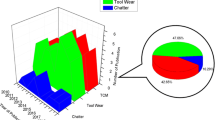Abstract
Condition monitoring of machine tool inserts is important for increasing the reliability and quality of machining operations. Various methods have been proposed for effective tool condition monitoring (TCM), and currently it is generally accepted that the indirect sensor-based approach is the best practical solution to reliable TCM. Furthermore, in recent years, neural networks (NNs) have been shown to model successfully, the complex relationships between input feature sets of sensor signals and tool wear data. NNs have several properties that make them ideal for effectively handling noisy and even incomplete data sets. There are several NN paradigms which can be combined to model static and dynamic systems. Another powerful method of modeling noisy dynamic systems is by using hidden Markov models (HMMs), which are commonly employed in modern speech-recognition systems. The use of HMMs for TCM was recently proposed in the literature. Though the results of these studies were quite promising, no comparative results of competing methods such as NNs are currently available. This paper is aimed at presenting a comparative evaluation of the performance of NNs and HMMs for a TCM application. The methods are employed on exactly the same data sets obtained from an industrial turning operation. The advantages and disadvantages of both methods are described, which will assist the condition-monitoring community to choose a modeling method for other applications.














Similar content being viewed by others
Explore related subjects
Discover the latest articles, news and stories from top researchers in related subjects.References
Teti R (1995) A review of tool condition monitoring literature database. Ann CIRP 44:659 –667
Sick B (2002) Online and indirect tool wear monitoring in turning with arti(fi)cial neural networks: a review of more than a decade of research. Mech Syst Signal Processing 16:487 –546
Ertunc HM, Loparo KA (2001) A decision fusion algorithm for tool wear condition monitoring in drilling. Mech Syst Signal Processing 41:1347–1362
Ertunc HM, Loparo KA, Ocak H (2001) Tool wear condition monitoring in drilling operations using hidden Markov models (HMMs). Mech Syst Signal Processing 41:1363–1384
Bunks C, McCarthy D, Al-Ani T (2000) Condition-based maintenance of machines using Hidden Markov Models. Mech Syst Signal Processing 14:597–612
Silva RG, Rueben RL, Baker KJ, Wilcox SJ (1998) Tool wear monitoring of turning operations by neural network and expert system classification of a feature set generated form multiple sensors. Mech Syst Signal Processing 12:319–332
Govekar E, Grabec I (1994) Self-organizing neural network application to drill wear classification. Trans ASME: J Eng Indust 116:233–238
Jiaa CL, Dornfeld DA (1998) A self-organizing approach to the prediction and detection of tool wear. ISA Trans 37:239–255
Dimla DE, Lister PM, Leighton NJ (1996) Investigation of a single-layer perceptron neural network to tool wear inception in a metal turning process. In: Proceedings of the 1997 IEE colloquium on modelling and signal processing for fault diagnosis, pp 3/1–3/4
Lou K, Lin C (1997) An intelligent sensor fusion system for tool monitoring on a machining centre. Int J Adv Manufacturing Technol 13:556–565
Baum LE, Eagon JA (1967) An inequality with applications to statistical estimation for probabilistic functions of Markov processes and to a model for ecology. Bull Am Math Soc 73:360–363
Wu M, Wang DL, Brown GJ, A multi-pitch tracking algorithm for noisy speech, IEEE Trans. on Speech and Audio Processing 11:229–241
Rabiner LR (1989) A tutorial on Hidden Markov Models and selected applications in speech recognition. Proc IEEE 77(2):257–286
Rabiner LR, Juang BH (1986) An introduction to hidden Markov models. IEEE ASSP Mag 1(3):4–16
Scheffer C, Heyns PS (2004) An industrial tool wear monitoring system for interrupted turning. Mech Syst Signal Processing 18:1219–1242
Scheffer C, Heyns PS (2002) A robust and cost-effective system for conducting cutting experiments in a production environment. In: Proceedings of 3rd CIRP international conference on intelligent computation in manufacturing engineering (ICME 2002), Ischia, Italy, 3–5 July 2002, p 329–334
Jawahir IS, Li PX, Gosh R, Exner EL (1995) A new parametric approach for the assessment of comprehensive tool wear in coated grooved tools. Annals of the CIRP 44:49–54
Kennedy J, Eberhart RC (1995) Particle swarm optimisation, Proceedings of the 1995 IEEE international conference on neural networks, vol 4. Perth, Australia, pp 1942–1948
Scheffer C (2002) Development of a wear monitoring system for turning tools using artificial intelligence. PhD Thesis, University of Pretoria
Bakis R (1976) Continuous speech word recognition via centisecond acoustic states, In: Proceedings of 91st meeting of the Acoustic Society of America (Washington, DC)
Levinson SE (1986) Continuously variable duration Hidden Markov model for automatic speech recognition. Comput Speech Lang 10:29–45
Russell MJ, Moore RK (1985) Explicit modelling of state occupancy in hidden Markov models for automatic speech recognition. In: Proceedings on international conference on Acoustic, Speech and Signal Processing, Tampa, 26–29 March 1985, p 5–8
Author information
Authors and Affiliations
Corresponding author
Rights and permissions
About this article
Cite this article
Scheffer, C., Engelbrecht, H. & Heyns, P.S. A comparative evaluation of neural networks and hidden Markov models for monitoring turning tool wear. Neural Comput & Applic 14, 325–336 (2005). https://doi.org/10.1007/s00521-005-0469-9
Received:
Accepted:
Published:
Issue Date:
DOI: https://doi.org/10.1007/s00521-005-0469-9




